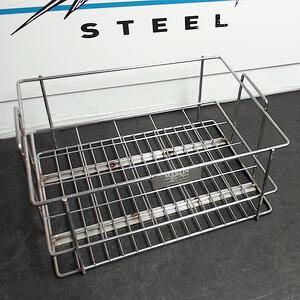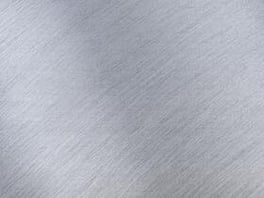 Pharmaceutical and food manufacturing companies have to meet stringent sanitizing standards when it comes to parts and tools. That's why many of Marlin Steel’s clients in these industries have asked which type of coating or finish is best for their stainless steel baskets and racks.
Pharmaceutical and food manufacturing companies have to meet stringent sanitizing standards when it comes to parts and tools. That's why many of Marlin Steel’s clients in these industries have asked which type of coating or finish is best for their stainless steel baskets and racks.
Sometimes, the answer will depend on the client’s precise application for the coating or finish. But more often than not, electropolishing is the superior finishing method when it comes to enhancing the performance of stainless steel.
QUICK LINKS
- What is Electropolishing?
- 7 Benefits of Using Electropolishing
- Electropolishing vs Other Finishes
- Choosing a Finish for Baskets, Trays, and Carts
What is Electropolishing
 Electropolishing, or electrochemical polishing, is the electrochemical process of removing material from a metallic workpiece. It involves using a temperature-controlled bath of electrolytes and an electric current to dissolve the surface layer of material. This reduces the surface roughness by leveling out microscopic peaks and valleys, leaving behind a smooth, featureless surface. The smoothness of this finish leaves the material almost perfectly nonstick, as almost all of the microscopic flaws that debris would normally stick to are removed.
Electropolishing, or electrochemical polishing, is the electrochemical process of removing material from a metallic workpiece. It involves using a temperature-controlled bath of electrolytes and an electric current to dissolve the surface layer of material. This reduces the surface roughness by leveling out microscopic peaks and valleys, leaving behind a smooth, featureless surface. The smoothness of this finish leaves the material almost perfectly nonstick, as almost all of the microscopic flaws that debris would normally stick to are removed.
Electropolishing steel is often performed in lieu of mechanically polishing stainless steel, which can be highly abrasive. Electropolishing is commonly used for applications in the food processing and pharmaceutical industries, as well as in the manufacture of semiconductors.
7 Benefits of Using Electropolishing inn Pharma & Food Manufacturing
Simply put, the electropolishing process makes a great material even better! Stainless steel is already a very strong, durable material, but electropolishing improves upon it in a number of ways, which is why Marlin Steel often recommends the finish to our pharma and food manufacturing clients. So how does electropolishing enhance stainless steel?
1. Enhanced Surface Appearance
In a medical or food setting, it can be just as important for a part or tool to look clean as it is for it to actually be clean. Electropolishing stainless steel gives it a clean and shiny appearance. This makes it easier to tell if the part or tool is sterile or not. Electropolishing stainless steel also increases weldability without affecting the hardness of the surface or introducing peeling or abrading.
2. Enhanced Uniformity
The microscopic smoothness of electropolished stainless steel gives parts and tools a uniform appearance from one to the next by stripping away imperfections such as weld and burn marks to leave a mirror-like, smooth finish.
3. Enhanced Corrosion Resistance
Electropolishing creates maximum resistance to tarnishing and corrosion in stainless steel. Electropolished metals can be subjected to a variety of chemicals and harsh environments (which is especially important when sterilizing them) without tarnishing and corroding.
4. Enhanced Sanitation Control
Sanitation is a key concern for any medical, pharmaceutical, and food manufacturing application. Electropolishing provides a nonstick surface so contaminants wash away with relative ease, and the smooth surface eliminates microscopic pits where they could proliferate and spread disease, bacteria, and viruses.
5. Enhanced Friction Resistance
Galling, adhesive wear caused by the microscopic transfer of material between metallic surfaces during motion is a common problem in complicated medical and food manufacturing machinery. It can also lead to seizing, an actual fusion of metallic materials. Having a microscopically smooth surface reduces friction between metal parts which helps prevent galling and seizing of equipment.
6. Enhanced Safety
Stainless steel electropolishing strips away sharps and burrs caused by welds or other metal forming processes. By eliminating them, metal forms are made safer for manual use. This helps to prevent minor injuries as well as accidental contamination risks from open cuts in a pharmaceutical or food manufacturing setting.
7. Enhanced Structural Integrity
The shaping process for parts can leave microscopic fissures on the surface, weakening it. This is especially prevalent in parts that have been cold-formed (i.e., bent without being heated up first). Many surface-layer micro-fissures are eliminated by electropolishing. It removes structural weak points that contribute to fatigue on parts, creating a stronger, longer-lasting form.
Electropolishing vs Other Finishes
How does electropolishing stack up against other types of finishes? Let’s take a look at passivation, sanding, and 2B surface finishes.
Passivation
This stainless steel finishing process involves using citric or nitric acid to remove free iron from the metal surface. The passivation chemical treatment provides a thick protective oxide layer on the product, making it resistant to chemical reactions with the air that corrode the stainless steel. The corrosion resistance that passivation provides helps to protect even the smallest parts of your stainless steel applications. This means you don't have to perform extra maintenance to ensure that rust doesn't weaken the bolts and small parts of your product that would cause your application to malfunction or fall apart.
While the passivation process can significantly alter the rust resistance of a part, it doesn’t significantly alter the appearance of the finished part. This is one of the major differences between passivation and electropolishing. Parts that have been electropolished can be readily identified by their smooth, shiny surface. Additional limitations to consider if you choose passivation:
- Welded parts may not be suitable for passivation because the process isn’t as effective as electropolishing at stripping contaminants from weld zones.
- The temperature and type of acid used in the passivation process have to be adjusted for the specific steel alloy. This adds cost and complexity to the process compared to electropolishing.
- Some stainless steel alloys that have low chromium and nickel content can actually be damaged by the acid bath.
Sanding
Sanding stainless steel is another finishing option. One of the biggest differences between electropolishing and sanding is that most sanding processes leave the metal part with a much rougher surface. This is less than ideal for most pharma and food manufacturing companies that want a smooth, contaminant-free surface for safety.
It is possible to achieve an electropolish-like finish with traditional sanding, however, this can be parts- and labor-intensive, requiring that a series of progressively finer abrasive pads be used. In addition to requiring multiple passes, these pads need frequent replacement to maintain optimum performance. Between the time and labor required, the cost of abrasive sanding could easily exceed electropolishing over the course of making hundreds of parts. Sandblasting is another option that’s faster and easier than sanding with abrasive pads., but it’s still inferior to electropolishing in terms of processing speed and final finish smoothness.
Electropolishing can have a higher initial setup cost to create the electrolytic bath. However, once it’s ready to go, the cost per part finished may be lower because of the reduced need for labor and replacement of abrasive pads.
Of course, for some applications, a rougher surface may actually be preferable (e.g., if the part needs to be gripped manually, a sanded, gritted surface is easier to hold on to versus a smooth, featureless surface) although special care needs to be taken to ensure that sharps and burrs are completely removed.
2B Surface Finish
2B is the term used by the ASTM A480 standard to define “a smooth, moderately reflective cold-rolled annealed and pickled or descaled finish typically produced by imparting a final light cold-rolled pass using polished rolls.” It is the most widely-used stainless steel finish available today because it is economical (by base cost), is chemically resistant thanks to the pickling process, and it has a relatively smooth surface.
In many applications, 2B surface finishes are perfectly suitable for the task at hand. However, they are often not as effective as electropolished finishes are for mechanical performance. And while having stainless steel electropolished might be costlier than using the “default” 2B finish, it is often well worth the added cost because of 2B’s limitations:
- 2B produces appearance variances between batches
- 2B does not create microscopically smooth surfaces
- 2B may result in micro-fissures that weaken structure integrity
Choosing a Finish for Pharma & Food Manufacturing Baskets, Trays, and Carts
When choosing a surface finish for your custom wire forms, such as parts washing baskets and transportation carts, it’s important to balance their performance needs thoroughly. This is one reason why Marlin Steel tests every wire basket and using advanced physics simulation software.
By testing the projected stresses of applications, our degreed engineers can spot performance issues that may otherwise have been forgotten. So, be sure to consult with an experienced Marlin Steel mechanical engineer before settling on a surface finish or coating for your stainless steel baskets, trays, and carts.



.gif)


